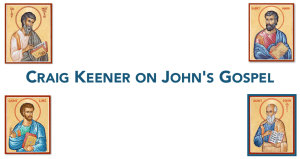A few weeks ago I noted my interest in writing a blog series on understanding the Gospels. Specifically of interest to me are the blog postings of Dr. Lydia McGrew, an analytic philosopher, who believes that evangelical New Testament scholarship is by-and-large misguided (to put it nicely). In that introductory post, I noted that not only do I find her arguments to be wanting, but her writing style to be uncharitable. In this post I would like to analyze her arguments against Craig Keener’s remarks on the Gospel of John.
But before going further, I received some pushback from a couple people regarding a conclusion of mine I made not long ago that McGrew is out of her depth on NT criticism. Interestingly enough, with her recent post critiquing Craig Keener (who wrote the foreword to her book!) a person shared with me an admission she made (a week ago) which bolsters my observation.
Her comment, “I had not read some parts of his work, particularly his commentary on John” serves as an indicator that Lydia was unfamiliar with Keener’s position on John’s liberties as a biographer. Additionally, and even better, her broader statement that “I’ve realized this even more in the last year or two” very well might be an admission that her reading of NT evan. scholarship was limited even just 1-2 years ago. As someone pointed out to me, this would only mean that she was out of her depth 1-2 years ago, not necessarily now. But if that were the case, then she would have a lot of catching up to do. A LOT. And so we move to the main purpose of this post.
In her recent post she critiques Craig Keener’s caution on four events in John’s Gospel: Jesus breathing on his disciples (John 20:19-23), Jesus carrying his cross (John 19:16-17), the day of the Last Supper (John 13), and who acquires the bread dipped in wine (John 13:21-27). Roughly speaking, Keener writes that he’s skeptical of John’s account of those events, at least in part, as actually occurring in space-time and that perhaps John is writing his account to draw a deeper theological truth the reader ought to know. Keener believes, “A close examination of the Fourth Gospel reveals that John has rearranged many details, apparently in the service of his symbolic message. This is especially clear in the Passion Narrative, where direct conflicts with the presumably widely known passion tradition (most notably that Jesus gives the sop to Judas, is crucified on Passover, and carries his own cross) fulfill symbolic narrative functions.”[1]
McGrew’s main concern is roughly this: She’s wondering why guys like Keener should even question the historicity of events in the Gospel of John at all if alternative hypotheses are more readily available.
She asks, “Why should we assume that John means to convey some clear, definite, theological meaning here to Jesus’ action?” and claims, “It is apparently almost impossible for NT scholars to acknowledge [a lack of ‘prima facie contradiction’] because they are insisting on resolving a purely theological question as a prerequisite to resolving an historical question.” These statements are made in response to one particular incident but could apply to alternative case studies.
The chief concern of mine is that she does not inquire of Keener’s reasons for being cautious. She has not sought out why Keener might think that way, she simply posits alternative theories of those events. (Aside: If it is objected that Keener should have explicitly and systematically provided those reasons in his commentary, why ought we to think that was Keener’s intention in his commentary??) For example, in her section on the day of the Passover meal she confidently asserts the issue has been solved.
[blockquote2]Esteemed Husband deals with it at the beginning of his video here. Craig Blomberg has done thorough work bringing into contemporary NT scholarship the insights that were known to older scholars. The claim that John changes the day of the crucifixion and the day of the Last Supper has been thoroughly answered again and again. Put bluntly, it just isn’t true.[/blockquote2]
If this has been thoroughly answered again and again, why is it that some of the highly respected evangelical NT scholars do not accept it? Do they simply lack the ability to think critically? Or perhaps they have reasons for thinking that McGrew’s hypothesis is flawed. Of course, she does not present the reasons why many scholars are hesitant to accept that interpretation (read a panel discussion, pgs 8-10, for some conversation between NT scholars on this). She does note Keener admits a possible interpretation of John 18:28 as referring to a different type of meal than the Passover meal, but no reasons why Keener himself rejects the Craig Blomberg/McGrew position. But more perplexing than this is her final example of the acquiring of the sop.

Therein she critiques Keener for stating an apparent conflict between John and Mark on whether Jesus passed the dipped bread to Judas or both Jesus and Judas were dipping their bread together. When I compared the passages I quickly recognized the possible conflict. In John 13:21-27 we read (hover over the text for the passage to pop-up) that Jesus says, “It is he to whom I will give this morsel of bread when I have dipped it.” In Mark 14:18-21 Jesus says, “It is one of the twelve, one who is dipping bread into the dish with me.” John’s account appears to give Jesus direct control over identifying his betrayer, whereas Mark’s account could be interpreted (inaccurately) to mean that Jesus is instantaneously identifying his betrayer. This interpretation is ultimately inaccurate because Jesus is simply making a general statement of sharing his dish with the twelve disciples. McGrew states that she does not see any direct conflict. This is where it gets interesting.
[blockquote2]A. McGrew rejects that there is an actual conflict.B. McGrew posits a possible conflict (which is a wooden reading of Mark’s “one who is dipping bread into the dish with me”)
C. McGrew provides a good solution to possible conflict (that Mark’s “one who is dipping bread into the dish with me” is a general statement Jesus making at the table, which explains why the disciples were genuinely confused as to who the betrayer would be).[/blockquote2]
C. Keener provides a good solution to the possible conflict (“but this reading does not explain well why the disciples did not recognize the betrayer (Mark 14:19)”.[3]
A. Keener rejects that there is an actual conflict (according to McGrew, herself, “Keener himself notes (p. 919, footnote 217) that such a strong reading of “with me” in Mark makes it hard to see why the other disciples did not understand that Judas was the one who would betray him.”)[/blockquote2]
As you can see, both McGrew and Keener agree there is a possible conflict, both McGrew and Keener agree there is a good solution, and both McGrew and Keener reject that there is an actual conflict. So what is McGrew critiquing against Keener?!
She asks “So, once again, where is the conflict?” To which the answer ought to be, ‘You just explained the supposed conflict qua strong reading of “with me.”’ McGrew’s criticism of Keener’s writing on this fourth example is unfair. One might think that she is making mountains out of molehills, but that would be unfair to the moles.
In my next post, I will be analyzing McGrew’s tone in her criticism of Keener versus Licona on the very same issues.
[1] Craig Keener, The Gospel of John: A Commentary, pgs. 42-43.
[2] Keener, pgs. 918-919, “But what may be more striking to those familiar with the Markan line of tradition is that Jesus does not identify the betrayer by the betrayer’s choice but by his own. In the Synoptics, Judas stretches out his own hand “with” Jesus, perhaps indicating a deliberate violation of rank, hence rebellion (Mark 14:20). Given how widespread the pre-Markan passion narrative that Mark used probably was (1 Cor 11:23), this tradition was probably known to John’s audience. Here, however, Jesus, rather than Judas, appears in full control of the betrayal (cf. 10:17–18)…”
[3]Keener, pg 919, ftnt 217.






Please login to comment